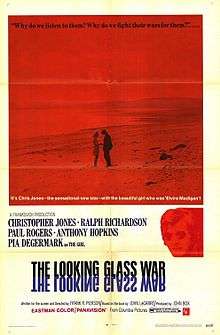The Looking Glass War
 First edition | |
| Author | John le Carré |
|---|---|
| Country | United Kingdom |
| Language | English |
| Genre | Spy novel |
| Publisher | William Heinemann (UK) & Putnam (USA) |
Publication date | June 1965 |
| Media type | Print (hardback & paperback) & Audio Cassette |
| Pages | 246 pp (hardback edition) |
| ISBN |
0-434-41200-7 (UK hardback edition) ISBN 0-698-10218-5 (US hardback edition) |
| OCLC | 257344327 |
| Preceded by | The Spy Who Came in from the Cold |
| Followed by | A Small Town in Germany |
The Looking Glass War (1965), by John le Carré, is a spy novel about a British Intelligence agency known as 'The Department' and its attempts to infiltrate an agent into East Germany.
Plot summary
During the early 1960s, a British military intelligence organisation based in Blackfriars Road, London and referred to as "The Department," has been largely inactive since successfully running agents against the Nazis during the Second World War. Its rival is the more experienced and professional "Circus" led by "Control" and George Smiley.
The Department interprets intelligence from a source as evidence that Soviet missiles are being placed at Rostock, near the West German border. The Department's chief, Leclerc, sees it as an opportunity to re-live glory days and regain ground in its turf war with The Circus. To get aerial photographs, The Department pays a civilian pilot to "accidentally" divert his flight over the area. The man sent to collect the film is killed, and the film is lost. Further blunders are made when Leclerc's assistant, Avery, tries to retrieve the body in the hope that the film is still among his effects. When Leclerc requests assistance, Smiley and the Circus are alerted to the The Department's new covert activities.
In spite of these compromising setbacks, The Department persuades the responsible Minister to allow them to send an agent into East Germany to discover the truth. Leclerc avoids involving The Circus directly, representing the whole operation as a training exercise. The Department reactivates one of its wartime agents, a middle-aged naturalised Pole named Fred Leiser. During his preparation and training, his handlers have Leiser believe that The Department is still the large, vital and competent organisation he remembers from the war years, hiding from him that he is now their only agent, and that his equipment, supplied by The Circus, is obsolete.
When crossing the border, Leiser kills a young East German guard, an outrage which is widely published in the East German media as the work of Western "provocateurs". Leiser meets a young German girl and makes radio transmissions from a hotel, forgetting to change frequencies. The East Germans are aware that security has been breached, and set about locating Leiser. After informing Leclerc and his colleagues about the debacle, Smiley tactfully convinces Leclerc to abandon the operation, and to leave Leiser trapped in East Germany, explaining that his obsolete equipment and techniques will make denials more plausible. Receiving no response to his further radio transmissions from the East German woman's flat, Leiser continues with his mission, following the "War Rules". He is located, captured; his ultimate destiny not told.
Smiley is sent by the Circus to round up Leclerc, Haldane and Avery, and terminate The Department's covert activities. Leclerc is diverted to a nonoperational role by convincing him of the existence of a massive fictitious "armoured spearhead" in Hungary. Haldane is upbraided for believing that the missiles existed in the first place - the site is an abandoned manoeuver ground, and their "defector" is a known hack with a previous record of identical fabrications. He is apparently mollified by their new roles as aides of Leclerc within an appended Research Section which presumably will be totally subservient to the Circus. Only Avery, who became devoted to Leiser, sobs inconsolably.
Characters
- Leclerc: Head of "The Department"
- Adrian Haldane: Veteran intelligence operative for The Department
- John Avery: Young agent assigned to Leiser
- Fred Leiser: naturalised Pole who served as agent during World War II
- Jack Johnson: Wireless operator assigned to train Leiser
- George Smiley: Envoy from The Circus
Adaptations

A film of the novel was released in 1969, starring Christopher Jones as Leiser, Ralph Richardson as LeClerc (sic), and Anthony Hopkins as Avery. It was directed by Frank Pierson.[1]
As part of a series of dramatisation of Le Carré's work, the "Complete Smiley" series, BBC Radio produced a radio play of The Looking Glass War in 2009. Broadcast on BBC Radio 4, it starred Ian McDiarmid as Leclerc, Piotr Baumann as Leiser, Patrick Kennedy as Avery, and Simon Russell Beale as George Smiley.[2] As with other plays in this series it is now available as a CD set as ISBN 978-1-4084-0086-9.
Release details
- 1965, UK, William Heinemann ISBN 0-434-41200-7, Pub date ? June 1965, Hardback
- 1965, USA, Putnam Pub. Group ISBN 0-698-10218-5, Pub date ? June 1965, Hardback
- 1965, USA, Coward-McCann, Inc., New York, Book Club Edition, Hardback
- 1966, UK, Pan, ISBN 0-330-20210-3, London, Paperwork
- 1985, UK, G. K. Hall & Co. ISBN 0-8161-4040-5, Pub date ? April 1986, Hardback (Large Print)
- 1991, UK, Hodder & Stoughton Ltd ISBN 0-340-55813-X, Pub date 21 November 1991, Hardback
- 1991, UK, Hodder & Stoughton (Coronet) ISBN 0-340-55446-0, Pub date 21 November 1991, Paperback
- 1992, USA, Ballantine Books ISBN 0-345-37736-2, Pub date ? March 1992, Paperback
- 1999, UK, Hodder & Stoughton ISBN 1-84032-108-3, Pub date 22 February 1999, Audio cassette (read by John le Carré)
References
- ↑ IMDb: The Looking Glass War (1969) Retrieved on 15 December 2009
- ↑ BBC: The Looking Glass War (2009) Retrieved on 15 December 2009